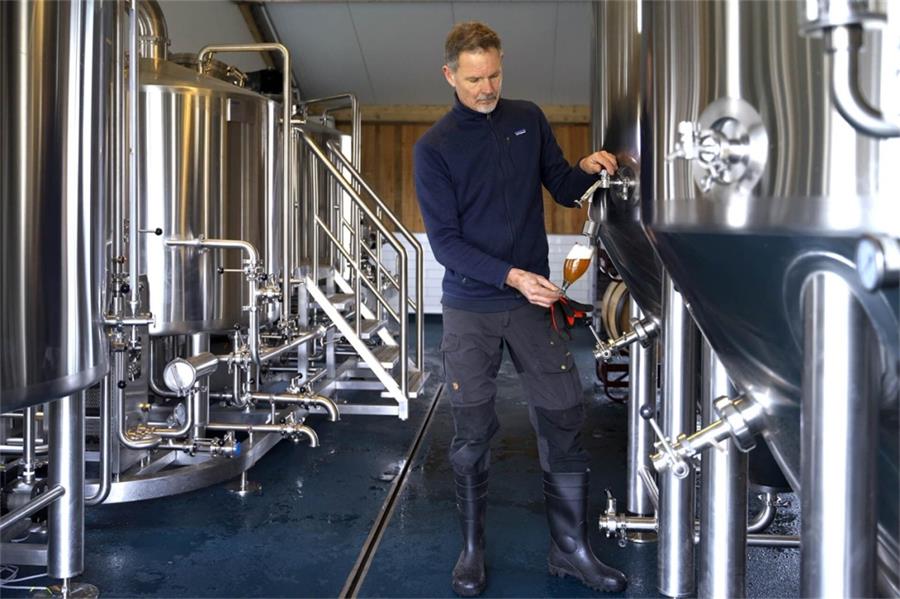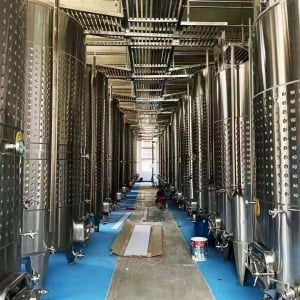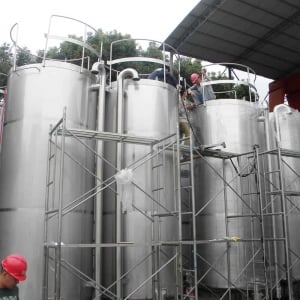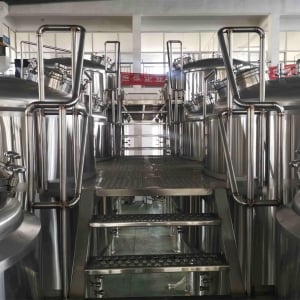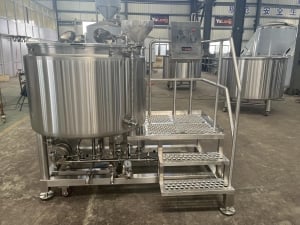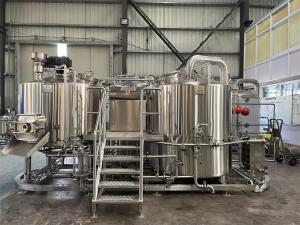Table of Contents
ToggleWhat Is Large Scale Brewing Equipment?
Large scale brewing equipment refers to specialized machinery and systems designed for producing beverages like beer on a commercial level. Unlike home brewing setups, which are smaller and more manual, large scale equipment is automated and capable of handling significant quantities of raw materials. This equipment is a fundamental component of modern breweries, enabling efficient and consistent production processes.
At its core, large scale brewing equipment is designed to streamline the various stages of the brewing process, from milling the grains to packaging the final product. It encompasses a range of interconnected systems that work together to transform raw ingredients into high-quality beer. These systems are characterized by their advanced automation, precise temperature and pressure controls, and the ability to produce large batches of beer in a single production cycle.
The key distinction between large scale brewing equipment and its smaller counterparts used in home brewing lies in the scale and complexity of the machinery. Large scale systems are engineered to handle substantial quantities of raw materials, often producing hundreds or thousands of gallons of beer per batch. This level of production requires advanced automation and control mechanisms to ensure consistency, quality, and efficiency throughout the brewing process.
Large scale brewing equipment plays a pivotal role in the commercial brewing industry by enabling breweries to meet the demands of a broader market. The automation and efficiency provided by this equipment allow breweries to produce consistent and high-quality beer at a larger scale, contributing to the growth and success of the craft beer movement and the overall beverage industry.
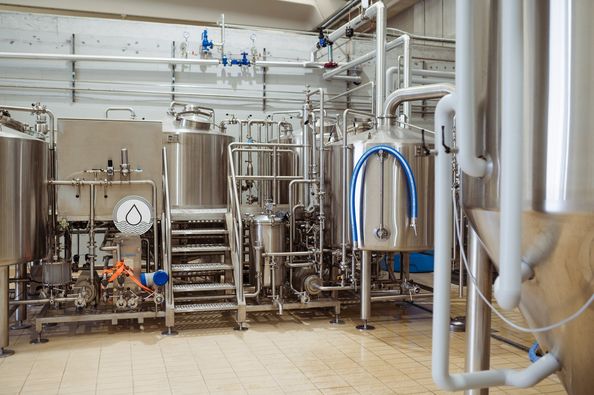
How Does Large Scale Brewing Differ from Home Brewing?
| Aspect | Home Brewing | Large Scale Brewing |
|---|---|---|
| Batch Size | Small, often under 10 gallons | Large, ranging from hundreds to thousands of gallons |
| Automation | Mostly manual processes | High level of automation |
| Equipment Complexity | Simple setups | Complex, integrated systems |
| Consistency | Variability due to manual handling | Consistency due to automation and quality control |
| Time Investment | More time per batch | Faster production |
Large scale brewing and home brewing are two distinct approaches to producing beer, each with its own characteristics, processes, and goals. While both share the common aim of creating delicious beer, there are significant differences between the two methods, particularly in terms of batch size, equipment, automation, and overall approach.
Batch Size
One of the most notable differences between large scale brewing and home brewing is the batch size. Home brewers typically work with smaller batch sizes, often under 10 gallons, due to the limitations of their equipment and space. In contrast, large scale breweries produce beer in much larger quantities, ranging from hundreds to thousands of gallons per batch. This higher volume production is made possible by the specialized equipment used in large scale brewing.
Automation
Automation is another key differentiator between the two brewing methods. Home brewing setups often rely on manual processes, where brewers manually control temperature, timing, and ingredient additions. Large scale brewing, on the other hand, leverages advanced automation technology. Temperature control, ingredient mixing, and timing are automated and precisely regulated using integrated systems. This automation ensures consistency and repeatability in the final product.
Equipment Complexity
The complexity of the equipment used in large scale brewing is significantly higher than that of home brewing setups. Large scale breweries employ intricate and integrated systems for mashing, boiling, fermenting, and packaging. These systems involve pumps, sensors, valves, and software to control various aspects of the brewing process. Home brewing equipment, while effective, is simpler in comparison and may require more manual intervention.
Consistency
Consistency in beer production is crucial for maintaining a brand’s reputation and customer loyalty. Large scale brewing equipment excels in achieving this consistency due to its automation and controlled processes. Every batch of beer produced using large scale equipment is highly reproducible in terms of flavor, aroma, and overall quality. Home brewing, while capable of producing excellent beer, may exhibit more variability due to the manual nature of the process.
Time Investment
Home brewing typically demands more time and attention per batch compared to large scale brewing. Home brewers engage in hands-on processes like manual stirring, temperature adjustments, and frequent monitoring. In contrast, large scale brewing equipment’s automation enables faster and more efficient production, reducing the overall time investment required for each batch.

What Are the Key Components of Large Scale Brewing Equipment?
Large scale brewing equipment consists of several essential components:
1. Milling System
The milling system is where the brewing process begins. Malted grains, usually barley, are ground into a consistent texture to expose the starches within. This process creates grist, which is then used in the mashing process to extract sugars.
2. Mashing System
In the mashing system, the grist is mixed with hot water in a vessel known as the mash tun. This mixture, called mash, undergoes a series of controlled temperature rests to activate enzymes that break down starches into fermentable sugars. The result is a sweet liquid called wort.
3. Boiling System
The wort is transferred to the boiling system, where it is boiled and hops are added. Boiling sterilizes the wort, extracts bitterness and flavor from the hops, and removes unwanted compounds. The boiling process also helps to concentrate the wort and set its final flavor profile.
4. Fermentation System
After boiling, the wort is rapidly cooled and transferred to the fermentation system. Yeast is introduced into the cooled wort, and fermentation begins. The yeast converts the sugars in the wort into alcohol and carbon dioxide, resulting in beer.
5. Cooling and Filtration
Once fermentation is complete, the beer undergoes cooling and filtration. Cooling stabilizes the beer’s temperature, while filtration removes residual solids, hops, and yeast. This step clarifies the beer and prepares it for packaging.
6. Packaging System
The final stage involves packaging the beer for distribution and consumption. The packaging system fills the beer into bottles, cans, or kegs. The containers are then sealed to maintain freshness and carbonation. This system often includes labeling and quality control measures.
Integration and Automation
What distinguishes large scale brewing equipment is the integration of these components. Advanced automation technology connects and regulates each stage of the brewing process. Sensors, pumps, valves, and control software work in tandem to ensure precise temperature control, timing, and ingredient additions. This integration minimizes the need for manual intervention, resulting in consistent and high-quality beer production.
What Are the Advantages of Large Scale Brewing Equipment?
Large scale brewing equipment offers several benefits:
1. Higher Production Capacity
One of the primary benefits of large scale brewing equipment is its ability to produce beer in larger quantities. With the capacity to handle significant volumes of raw materials, these systems can brew batches ranging from hundreds to thousands of gallons. This scalability allows breweries to meet growing market demand without compromising on quality.
2. Consistency
Large scale brewing equipment is designed for precision and repeatability. Advanced automation technology ensures that each batch of beer is produced with consistent parameters, including temperature, timing, and ingredient ratios. This consistency is crucial for maintaining the quality and flavor profile of the beer, enhancing brand reputation.
3. Cost Efficiency
Economies of scale play a significant role in large scale brewing. Producing larger quantities of beer per batch reduces the per-unit cost of production. This cost efficiency enables breweries to allocate resources to other areas of operation, such as marketing, distribution, and innovation.
4. Quality Control
Large scale brewing equipment integrates advanced quality control mechanisms. Sensors and monitoring systems track various parameters throughout the brewing process, allowing brewers to identify and address deviations promptly. This attention to detail ensures that only high-quality beer reaches the market.
5. Faster Production
Automation in large scale brewing equipment accelerates the production process. Tasks that would require manual intervention in smaller setups are streamlined through automation, reducing the time needed to brew each batch. This increased production speed enables breweries to respond to market demands more effectively.
6. Recipe Replication
Consistency in large scale brewing equipment enables accurate recipe replication. Brewmasters can fine-tune recipes and ensure that the same flavor profiles are achieved in each batch. This predictability is vital for breweries aiming to create recognizable and beloved beers.
7. Enhanced Experimentation
While large scale brewing is often associated with consistency, it doesn’t stifle creativity. Breweries can use the controlled environment provided by large scale equipment to experiment with new ingredients, techniques, and styles while maintaining a level of quality assurance.
How Does Automation Impact Brewing?
Automation in large scale brewing equipment significantly impacts the brewing process:
Precise Temperature Control
Automation allows brewers to maintain precise temperature profiles during mashing, boiling, and fermentation. This level of control ensures that enzymes are activated at the right temperatures for optimal starch conversion and flavor extraction, resulting in consistent and reproducible beer profiles.
2. Recipe Reproducibility
With automated systems, recipes can be accurately replicated from batch to batch. By precisely controlling parameters such as ingredient quantities, timing, and temperature, breweries can consistently recreate the same flavors, aromas, and characteristics that define their signature beers.
3. Data-Driven Decision Making
Sensors and monitoring systems integrated into automated equipment provide real-time data on various brewing parameters. Brewers can access data on temperature, pressure, pH, and more, allowing them to make informed decisions and adjustments to ensure the desired outcomes.
4. Quality Control
Automation enhances quality control by minimizing human error. Automated processes reduce the risk of inconsistencies caused by manual handling, leading to more consistent product quality. Deviations from desired parameters can trigger alerts, enabling brewers to intervene promptly.
5. Efficient Resource Utilization
Automated systems optimize resource utilization, such as energy, water, and raw materials. Precise control over processes ensures that resources are used only as needed, reducing waste and environmental impact.
6. Labor Savings
Automation reduces the need for manual labor during various stages of brewing. Brewers can focus on overseeing operations rather than performing repetitive tasks. This not only improves efficiency but also allows skilled personnel to allocate their time to more strategic and creative aspects of brewing.
7. Remote Monitoring
Some automated systems offer remote monitoring capabilities. Brewers can track the progress of the brewing process and receive alerts on their smartphones or computers, enabling them to manage operations even when not on-site.
8. Innovation and Experimentation
Automation provides a controlled environment for experimentation. Brewers can explore new ingredients, techniques, and recipes while maintaining consistent parameters. This accelerates the innovation cycle and encourages the development of new and exciting beer styles.
Are There Different Types of Large Scale Brewing Systems?
Yes, there are different types of large scale brewing systems, each offering unique advantages and catering to specific production needs. Breweries can choose from various system designs based on factors such as batch size, efficiency, and the level of automation required. Here are some of the most common types of large scale brewing systems:
1. Batch Systems
Batch systems are a traditional approach to brewing that involves producing one batch of beer at a time. In this setup, the entire brewing process, including mashing, boiling, and fermentation, takes place within individual vessels. Batch systems are well-suited for craft breweries that prioritize quality and variety. They offer the flexibility to experiment with different recipes and styles but may require more manual labor and time per batch.
2. Continuous Systems
Continuous brewing systems, also known as continuous fermentation systems, offer a more streamlined and efficient approach to brewing. Instead of producing beer in individual batches, these systems operate continuously, with a constant flow of ingredients and beer through the various stages. Continuous systems are highly automated, enabling breweries to achieve higher production rates and consistency while minimizing downtime between batches.
3. Combination Systems
Combination systems blend elements of batch and continuous brewing, providing breweries with flexibility and efficiency. These systems allow for the production of larger quantities of beer while retaining the ability to experiment with different recipes and styles. Combination systems may involve continuous mashing or fermentation processes combined with batch boiling or other stages.
4. Multi-Vessel Systems
Multi-vessel systems involve separate vessels for different stages of the brewing process. This modular approach allows breweries to optimize each stage individually for efficiency and control. For example, a multi-vessel system might include dedicated vessels for mashing, lautering, boiling, and fermentation. This type of system is highly customizable and allows for precise control over each brewing stage.
5. Fermenter-Centric Systems
Fermenter-centric systems prioritize fermentation as a central stage of the brewing process. Breweries using this approach often have a larger number of fermenters than other vessels. This setup allows for continuous production, as new batches can begin fermentation while others are being packaged. Fermenter-centric systems are well-suited for breweries focusing on fermentation-driven beer styles.
6. High-Gravity Systems
High-gravity brewing involves producing a concentrated wort that is later diluted to achieve the desired alcohol content. This method allows for more efficient use of equipment and resources, as well as reduced energy consumption. High-gravity brewing is common in larger breweries and contributes to cost savings and sustainability efforts.
How Do Large Scale Breweries Ensure Quality?
Large scale breweries maintain quality through:
Ensuring consistent and high-quality beer production is paramount for large scale breweries to maintain their reputation and meet customer expectations. To achieve this, breweries implement a range of strategies and processes that encompass every stage of production. Here’s how large scale breweries ensure quality:
1. Quality Control Departments
Large scale breweries typically have dedicated quality control departments responsible for monitoring and maintaining the quality of their products. These departments employ trained professionals who oversee various aspects of the brewing process, from raw material inspection to final packaging.
2. Sensory Analysis
Sensory analysis involves evaluating the beer’s taste, aroma, appearance, and mouthfeel. Large scale breweries often have tasting panels comprising experienced tasters who assess each batch of beer for consistency and adherence to desired flavor profiles.
3. Lab Testing
Laboratory testing plays a crucial role in quality assurance. Samples from different stages of production are tested for parameters such as alcohol content, bitterness, pH levels, and microbial contamination. This data-driven approach helps identify deviations and ensure that the beer meets the brewery’s specifications.
4. Process Monitoring
Automation technology integrated into large scale brewing equipment allows real-time monitoring of critical parameters. Sensors track temperature, pressure, and other variables, enabling brewers to intervene immediately if any parameters deviate from the desired range.
5. Cleaning and Sanitization
Strict cleaning and sanitization protocols are essential to prevent contamination and off-flavors. Large scale breweries follow meticulous cleaning routines to ensure that equipment is free from residual materials or contaminants that could affect the beer’s quality.
6. Quality Assurance Documentation
Breweries maintain comprehensive documentation of their quality assurance processes. This includes records of testing results, production parameters, and any deviations encountered. Having a detailed record helps trace the history of each batch and facilitates problem-solving if quality issues arise.
7. Employee Training
Brewery staff receive ongoing training to ensure they understand and follow the established quality control procedures. Well-trained employees are more likely to detect and address issues promptly, minimizing the risk of quality-related problems.
8. HACCP (Hazard Analysis and Critical Control Points)
HACCP is a systematic approach to identifying and managing potential hazards that could compromise food safety and quality. Large scale breweries implement HACCP plans to prevent, monitor, and control risks throughout the brewing process.
9. Traceability
Large scale breweries implement traceability systems that allow them to track ingredients and processes for each batch of beer. This traceability aids in identifying the source of any quality issues and taking corrective actions.
10. Continuous Improvement
Large scale breweries emphasize continuous improvement in their quality control processes. Regular audits, feedback loops, and data analysis help identify areas for enhancement, leading to refined processes and better quality outcomes.
FAQ
1. Can small breweries afford large scale equipment?
Yes, small breweries can invest in used or smaller-scale large brewing equipment to accommodate their production needs.
2. Are large scale brewing systems customizable?
Absolutely, large scale brewing systems can be customized to fit the specific requirements and recipes of a brewery.
3. What’s the typical lifespan of large scale brewing equipment?
With proper maintenance, large scale brewing equipment can last for many years, often a decade or more.
4. How long does it take to brew a batch using large scale equipment?
The brewing time varies, but it can range from a few hours to several weeks, depending on the beer type and fermentation time.
5. Can large scale brewing equipment handle different types of beverages?
While primarily designed for brewing beer, some large scale equipment can be adapted for producing other beverages like cider.
6. Do large scale breweries contribute to sustainability?
Yes, many large scale breweries implement sustainable practices, such as water and energy conservation, to minimize their environmental impact.
7. What’s the role of technology in modern large scale brewing?
Technology plays a significant role, enabling precise control over processes, data-driven decision-making, and remote monitoring of brewing operations.

